Knowing how many ounces in a cup of coffee helps make quality brew and measure caffeine. In this post, you’ll learn the standard coffee cup size. Plus, we’ll compare cup sizes of 3 coffee shops: Starbucks, Dunkin’, and Tim Hortons.
There are 6 ounces in a standard cup of coffee. This is a liquid measure of the brewed coffee, not the capacity of the physical cup. The 6-ounce measurement equals one “cup” in a standard coffee maker. And it’s based on the golden ratio for well-brewed coffee.
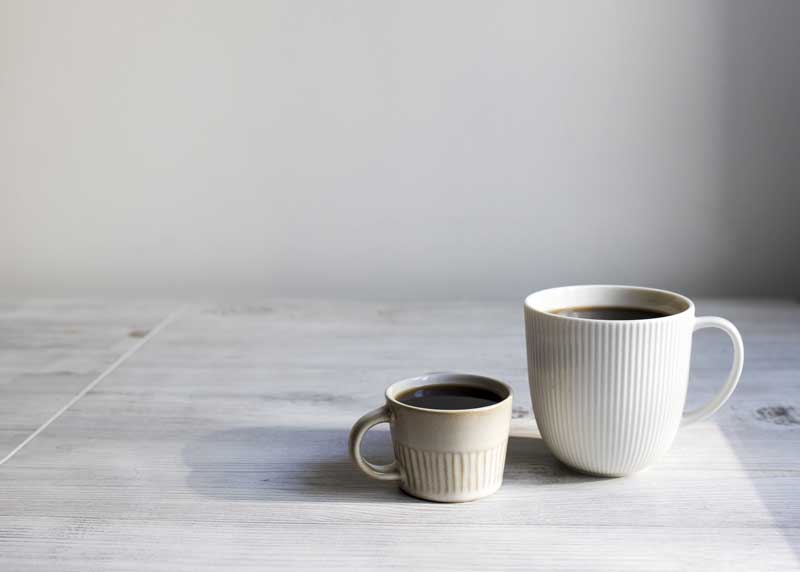
While the volume of a regular “cup” measurement equals 8 fluid ounces, in the US, most of the world uses the metric system and has different “cup” measurements and brewing methods.
Understanding that a coffee cup is not the same as a regular cup measurement is the first step in knowing why this all matters, but there is so much more to measuring coffee that we are going to talk about.
But first, let’s sort out how many ounces are in a coffee cup.
Table of Contents
Why is a Cup of Coffee Six Ounces?
How many ounces in a cup of coffee? There are six ounces (177 ml) in a standard cup of coffee.
Why is a cup of coffee 6 ounces? It appears to be an antiquated unit of measurement. 6 ounces of coffee is part of the golden ratio for brewing coffee.
This 6 ounces of coffee will be poured into an 8 or 12-ounce cup.
What is coffee’s Golden Ratio? For every 6 ounces of water, add 1 to 2 tablespoons of ground coffee. It is this ratio that has given us the six-ounce cup of coffee.
But as you’ve noticed, most coffee cups are much larger than 6 ounces. No one is really drinking just 6 ounces of brewed coffee in their cup.
Why aren’t all coffee cups 6-ounces? Over the past few decades, coffee mugs have become supersized, like much of North American food (thanks MacDonald’s).
This supersizing effect is one reason we’ve seen coffee mugs go from 8-10 ounces to 16, even 20 ounces.
Coffee Cup vs Coffee Mug Size
A six-ounce cup of coffee is a liquid measurement, used when brewing the coffee. It doesn’t measure the cup capacity.
A coffee mug, in contrast, measures the capacity of the physical mug.
It can be confusing to talk about such a tiny cup of coffee. But no one is drinking brewed coffee from a 6-ounce cup.
Does a 6 Ounce Cup of Coffee Matter?
When making coffee, standardization is important. If everyone just measured water with their mug, the results would vary. Because not all mugs are the same size.
Having a standard unit of measure for good coffee is important. And that’s where the golden ratio comes in.
If you have a drip coffee maker, I’m sure you have noticed that 6 cups on the maker don’t fill your mug 6 times.
That’s because it’s measuring in units of 6 ounces. Six coffeemaker cups will make just 36 ounces of coffee. This will fill your 12 oz coffee mug just 3 times (not 6 as promised).
How Many Ounces in a Coffee Cup? 4 Sizes
Here are the different sizes of coffee cups and what they’re for.
- Cup of Coffee: 6 ounces. This is the standard liquid measurement of a cup of brewed coffee. This doesn’t measure the physical capacity of the cup.
If you’re going to consume 6 ounces of coffee, you’ll need a cup larger than 6 ounces. Otherwise, it’ll be spilling everywhere. Plus there won’t be any space for additives, like sweeteners or cream.
And here are the 3 most common coffee cup sizes.
- Espresso Glasses: 2 oz. Like these double-walled espresso glasses by De’Longhi.
- Standard Coffee Mug: 10 to 16 oz. In the past, I ran a promotional products company. And we sold a lot of coffee cups (pallets and pallets full of coffee mugs). The standard, utility coffee mug is 10 fl oz. But we also sold many at 12, 14, and 16 ounces. Here is a basic mug at 11 oz and a huge 21 ounce mug.
- Travel Mug: 16 oz. This is a standard size for most insulated travel mugs. Like this one by Thermos that I’ve been using for 6+ years. It actually keeps drinks hot all day.
What are the common cup sizes at popular coffee shops? Here are the cup capacities of three of the most popular coffee shops in North America: Starbucks, Dunkin’, and Tim Hortons.
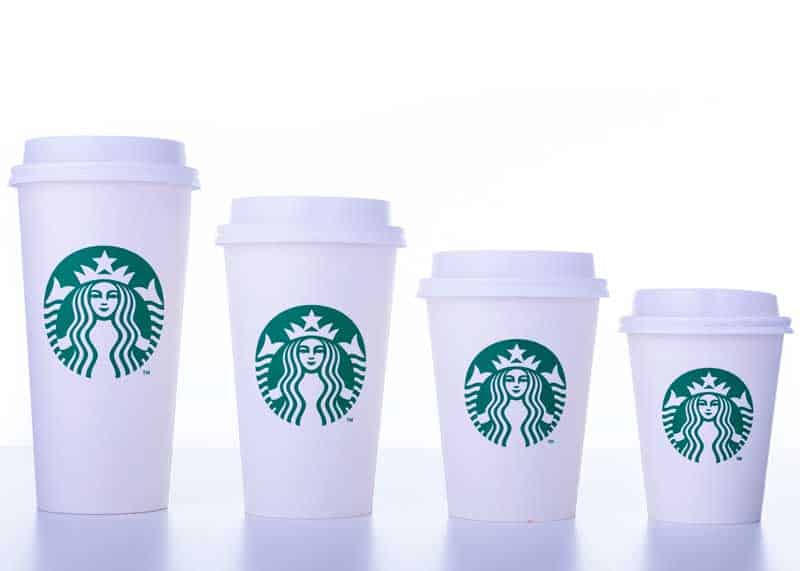
6 Starbucks Coffee Cup Sizes: oz/ml
Starbuck coffees come in 6 different sizes.
- Short: 8 fl. oz. (240 milliliters)
- Tall: 12 fl. oz. (350 milliliters)
- Grande: 16 fl. oz. (470 milliliters)
- Venti Hot: 20 fl. oz. (590 milliliters)
- Venti Cold: 24 fl. oz. (710 milliliters)
- Trenta Cold: 31 fl. oz. (920 milliliters)
If you have trouble remembering which one is larger/smaller, a little Italian will help. In Italian, grande is large, venti is 20 and trenta is 30. The exception is the English words short and tall.
And there used to be a 3 fl. oz. (89 milliliters) drink known as demi. Demi is French for half. Demitasse cups are a common way to serve espresso.
No wonder it is confusing.
Here’s how to order coffee in Italian. And if you know a little Spanish, it will help with the Italian words.
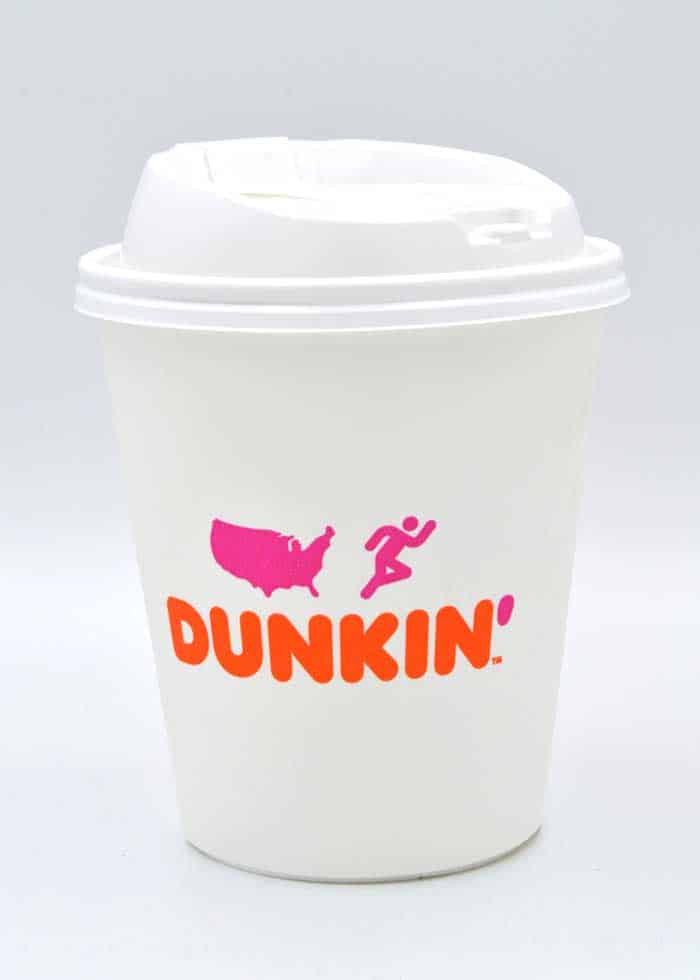
4 Dunkin’ Donuts Cup Sizes: oz/ml
- Small: 10 fl. oz. (296 milliliters)
- Medium: 14 fl. oz. (414 milliliters)
- Large: 20 fl. oz. (590 milliliters)
- Extra Large: 24 fl. oz. (710 milliliters)
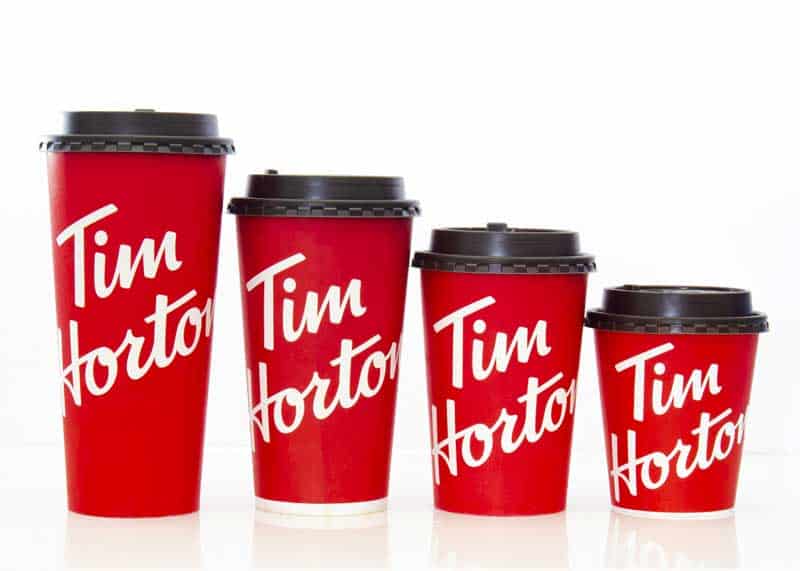
4 Tim Horton’s Cup Sizes: oz/ml
You’ll notice some similarities in Tim Horton’s cup sizes compared to Dunkin’ Donuts. They are exactly the same.
- Small: 10 fl. oz. (296 milliliters)
- Medium: 14 fl. oz. (414 milliliters)
- Large: 20 fl. oz. (590 milliliters)
- Extra Large: 24 fl. oz. (710 milliliters)
If you’re a Canadian, you probably have Tim Horton’s pumping through your veins. There are more than 4,800 locations in Canada. And they have a 54% share of the Canadian coffee market.
You can find hundreds of locations in the United States and the Middle East, 20 in the UK and Mexico, and another 77 locations in Asia.
Tim Horton’s had an extra small size, 8 fl. oz. (240 milliliters) but was phased out back in 2014.
There were some claims of the extra-large cup capacity actually being the same as their large. Because of a taller, slimmer extra-large cup, conspiracy theories ran wild. CBC journalist, Jason Proctor, debunked the myth in a simple test.
Coffee Cups: Different Sizes Around the World
The standard sizes of coffee mugs in North America are often much larger than in other countries.
While many countries drink small, rich coffee, North American coffee drinks are often 14 ounces or more.
These large sizes are standard for a morning cup of coffee, and many people drink several every day. In a typical American coffee shop, the smallest size is a 12 oz cup, but customers often purchase a larger size.
Why are coffee cup sizes different between countries? The main factor is the type of coffee popular in each region.
- Espresso is made and consumed in one, two, or three-ounce servings. Other types of coffee, like Moka pot and Turkish coffee, are consumed in small volumes because of how rich each ounce is.
- On the other hand, other types of coffee are not made strong and have steamed milk, foamed milk, cream, marshmallows, lemon, sugar, nitrogen, butter, coconut oil, alcohol, or water added. This adds volume and dilutes the coffee.
Different Measurement Systems for a Cup
Another factor in the different-sized coffee cups is the different measuring systems that countries use.
Here is how a cup is measured around the world.
- The United States uses the imperial system, which defines a cup as 8 fl. oz. (or 240 ml).
- In Japan, a cup is 200 milliliters. But the traditional Japanese unit is 180.4 ml.
- In Latin America, a cup varies across countries. It can be between 200 and 250 ml.
- In Canada, a cup is 250 milliliters – the metric standard. But a Canadian cup is actually 227 ml. This can get really confusing.
So while differing measuring systems might not seem significant, it does illustrate the lack of a cohesive unit of measurement. Which explains why the size of a cup of coffee is also inconsistent around the earth.
In North America, coffee shop coffee tends to be more watered down than it is in other countries. Plenty of milk, cream, and sugar is added to coffee to make it taste better and to make a bigger cupful.
In other countries, many prefer smaller cups of stronger, richer coffee. Like espresso and espresso-based drinks.
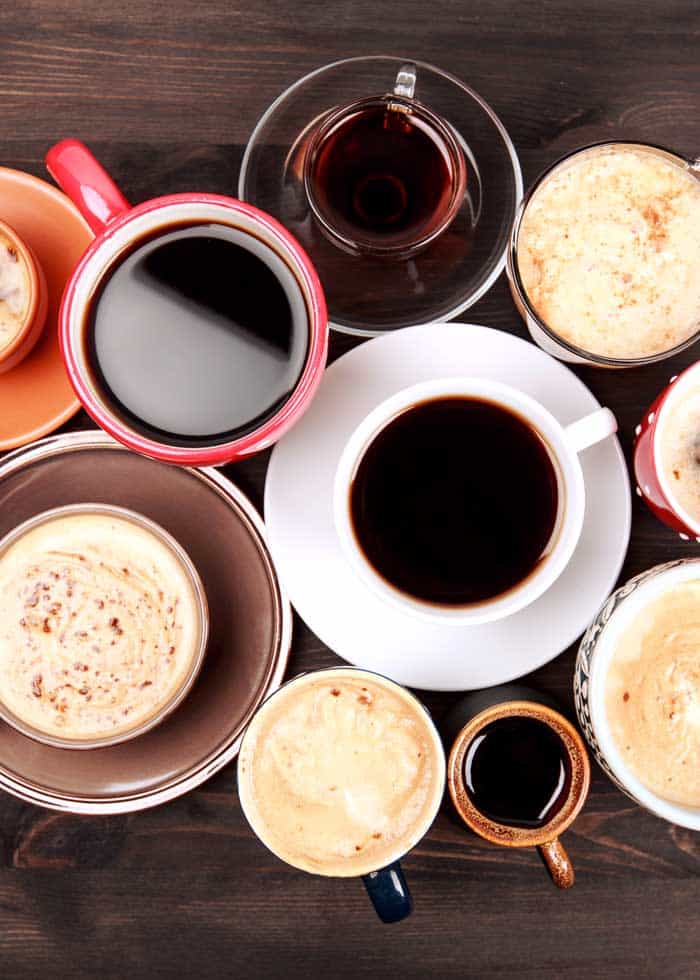
Cup size affected the amount of caffeine in each serving. Heres how caffeine levels between tea and coffee compare.
Two Factors of Cup Size
The different brews of coffee and the grind size can have an effect on the cup size of a coffee.
Some brews, require more room in the cup to accommodate milk and cream, while others, such as a strong, rich brew, are intended to be drank black and in smaller portions.
The grind size of the coffee can also play a part in deciding the cup size and how strong the coffee will be.
Grind Size
Grind size can play a part in determining cup size.
To understand why grind size is important, you need to know that usually the stronger the coffee, the smaller the cup. Picture the size of an espresso cup.
Grind size is one of the factors in determining if your coffee is going to be strong or weak. With strong coffee, the water has more contact with the coffee grounds. With weaker coffee, there is less contact.
Here’s how grind size can affect that:
- Strong coffee will usually be brewed with fine or extra-fine grind size. Because the grounds are smaller, as the hot water moves through them, it has more contact with the coffee grounds, therefore picking up more flavor.
- Weaker coffee will usually be brewed with coarse or medium-coarse grounds. The hot water can’t come in contact with as much of the coffee grounds, so it picks up less flavor.
Here’s how to grind your coffee beans without a grinder.
Finer ground coffee is typically used to produce smaller cups of coffee. This is because of how strong it is. Examples would be an espresso, Turkish coffee, and a moka pot brew.
A coarse grind is often used to brew larger cups of coffee. The drink isn’t as strong, so a person can drink more. Examples would be drip coffee, pour-over coffee, and french press.
The exception to this is when you are talking about large coffee drinks that have espresso as their base, which most do. The espresso is very strong but because it is mixed with steamed and foamed milk it is served in a larger cup.
Ready for a strong cup of coffee? Check out: The Strongest Coffee in the World
Different Brews
Different types of coffee require different size cups. This is applicable everywhere, as espresso is going to be very small and strong, while a latte is going to be larger and weaker tasting.
While grind size determines the strength of a cup of coffee with no additions, most people prefer their coffee to have milk, cream, or sugar.
To accommodate add-ins, the cup needs to be larger for some drinks.
Small and Medium drinks: Small and medium-sized drinks are around 2-8 oz.
Some of the common small drinks are espressos and macchiatos, while medium drinks are often cappuccinos and flat whites. These drinks all have espresso as their base
Large Coffee Drinks: Larger drinks are usually 8-16 oz.
Some examples of large drinks are Americanos, lattes, and mochas.
These also have espresso as their base but have large cup sizes because they need extra room for a lot of additives.
Lattes are especially known for being in huge cups with a lot of steamed milk in them.
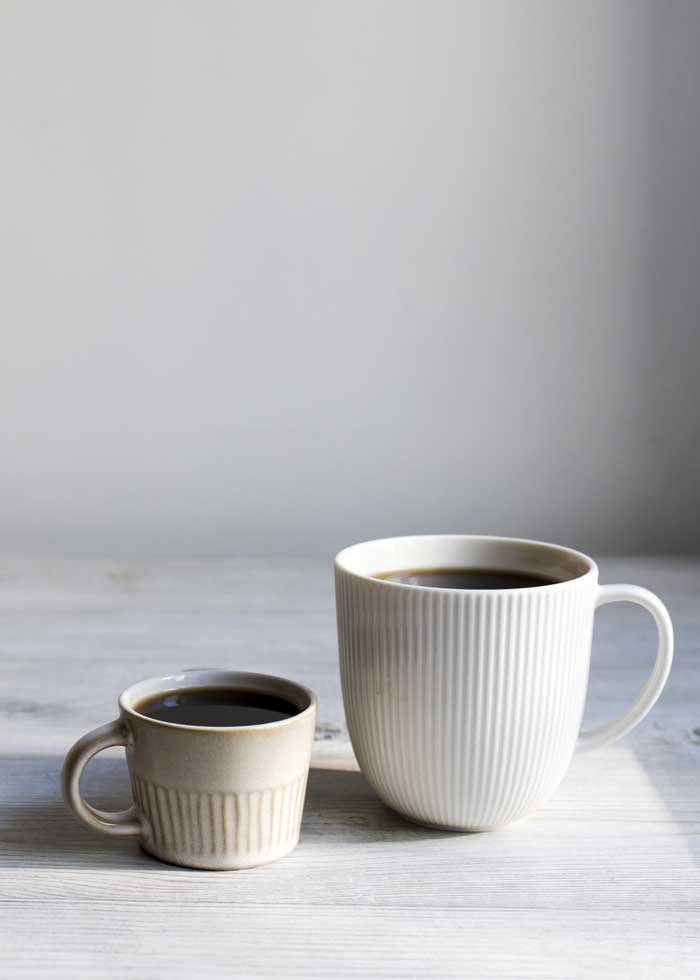
Keep Reading: How Many Cups of Coffee in a Pound?
Your Turn
And there you have it, how many ounces are in a cup of coffee? How large do you like your coffee? Have a fact to share? Or maybe a question? Let me know in the comments!
- About the Author
- Latest Posts
Bryan Haines is a co-founder and writer on EnjoyJava – and is working to make it the best coffee blog in the world.
He is a travel blogger at Storyteller Travel and blogs about photography at Storyteller Tech. He is also co-founder of Storyteller Media, a company he started with his wife, Dena.

Bruce Callahan
Tuesday 5th of October 2021
You missed Keurig with the stainless basket. I think I am getting 65–70 cups per pound of coffee. One level tablespoon of coffee fills the basket to 3/4 full.
Bryan Haines
Tuesday 5th of October 2021
Thanks Bruce!